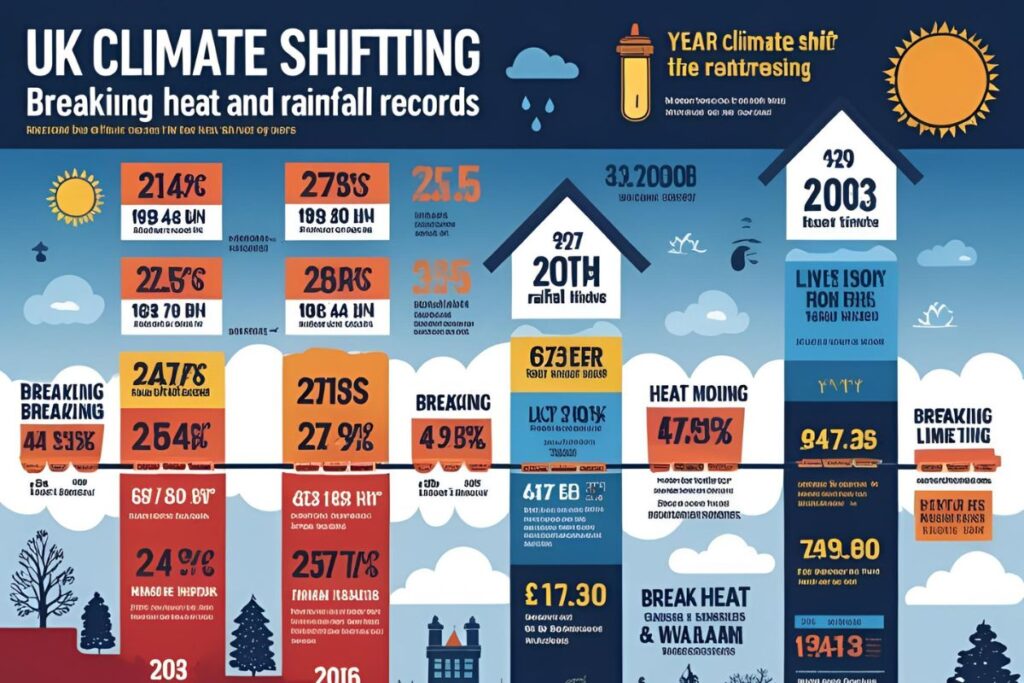
The UK is undergoing a dramatic climate transformation, according to the Met Office’s annual State of the UK Climate report. Increasing heatwaves, floods, and unpredictable weather patterns have become part of the new normal, with recent years consistently breaking temperature and rainfall records.
The 2024 report highlights a “notably different” climate compared to just a few decades ago—driven by global warming and greenhouse gas emissions. The Met Office is sounding the alarm: extreme weather events are no l onger rare but are becoming regular features of life in the UK.
A Year of Extremes: Record Heat and Rainfall in 2024
The year 2024 stands out for multiple climate milestones:
- Second-warmest February
- Warmest May and Spring on record
- Fifth-warmest December and winter since 1884
These trends continued into 2025, with the UK already enduring three heatwaves this summer, affecting areas from southern England to Wales, Northern Ireland, and Scotland.
The hottest June on record followed the driest and sunniest spring in over 130 years, prompting the first hosepipe bans in Yorkshire and a drought declaration in the north-west. Additional regions are expected to be added to the drought list soon, according to the National Drought Group.
Warming at a Rapid Pace: 0.25°C per Decade
The Met Office reports that the UK is warming by 0.25°C per decade, with the 2015–2024 decade averaging 1.24°C warmer than the 1961–1990 baseline. This rate of warming far exceeds anything observed in the past 300+ years of recorded data from the Central England Temperature record—the world’s longest-running climate dataset dating back to 1659.
Mike Kendon, lead climate scientist and author of the report, remarked:
“Every year is another upward step in our warming climate. Our weather is no longer what it was just decades ago.”
Hotter, Wetter, and More Unpredictable
The UK’s unique position between the Atlantic Ocean and continental Europe makes its climate naturally variable. But this variability is now increasingly skewed toward extremes. The Met Office notes:
- Significantly fewer extremely cold nights
- More very hot days
- Increased winter rainfall
From 2015 to 2024, winter rainfall rose 16% compared to 1961–1990 averages, pointing to a notable trend toward wetter winters. This, combined with warming, intensifies flood risk, storm severity, and infrastructure stress.
Flooding: The UK’s Greatest Weather Threat
Floods and storms continue to cause the most severe weather-related damage across the UK. The 2023–2024 winter was the wettest half-year period in over 250 years, driven by a series of storms beginning in autumn 2023.
Notable flood incidents included:
- Eastern Scotland, Derbyshire, Nottinghamshire, and the West Midlands recording 3–4x their typical September rainfall
- Stratford-upon-Avon cancelling performances due to floodwaters
- Tenbury Wells experiencing building collapses from surging brooks
Professor Stephen Belcher, Met Office Chief Scientist, stressed the need for climate adaptation:
“We must prepare for even more extreme weather as the climate continues to change.”
Rising Sea Levels: A Growing Coastal Risk
For the first time, the Met Office confirms that UK sea levels are rising faster than the global average, intensifying long-term flooding risks in low-lying coastal areas.
Dr Svetlana Jevrejeva of the National Oceanography Centre warned:
“It’s only a matter of time until the UK is hit by another major storm surge.”
Nature on the Brink: Ecosystems Struggling to Keep Up
- The natural world is also bearing the brunt of the UK’s changing climate. In 2024:
- 12 out of 13 seasonal events occurred earlier than average
- Frogspawn and blackbird nesting r eached their earliest levels since records began in 1999
This phenomenon, known as phenology, signals major disruptions to ecological cycles. Hedgehogs and dormice, two of the UK’s most threatened mammals, struggle when fruit and nuts ripen too early, reducing autumn food supplies essential for winter survival.
Forests Under Stress: Can UK Woodlands Survive?
At the Alice Holt forest research centre, scientists are studying how to build resilient forests in a hotter, wetter future. Unfortunately, many native UK tree species are already struggling under climate stress.
Dr Gail Atkinson, Head of Climate Change Science, observed:
“After droughts, we see stunted growth. Leaves become ragged, and in severe cases, trees simply die.”
Encouragingly, trials with coastal redwoods from California—the world’s tallest trees—show they could thrive in the UK’s future climate. The centre has been testing various tree species for over 60 years, p reparing for inevitable shifts in climate suitability.
The Takeaway: Climate Resilience Must Be a National Priority
The UK’s climate is changing fast, with record temperatures, rising seas, and unpredictable weather patterns reshaping everything from city infrastructure to rural ecosystems. As warming continues at a measurable pace, the call for sustainable adaptation grows louder.
Key steps for national resilience include:
- Investing in flood defenses
- Upgrading infrastructure
- Greening urban spaces
- Supporting biodiversity and ecosystem health
- Promoting sustainable land and water management
The Met Office’s report leaves no doubt: climate change is not a distant threat—it’s happening here and now.






